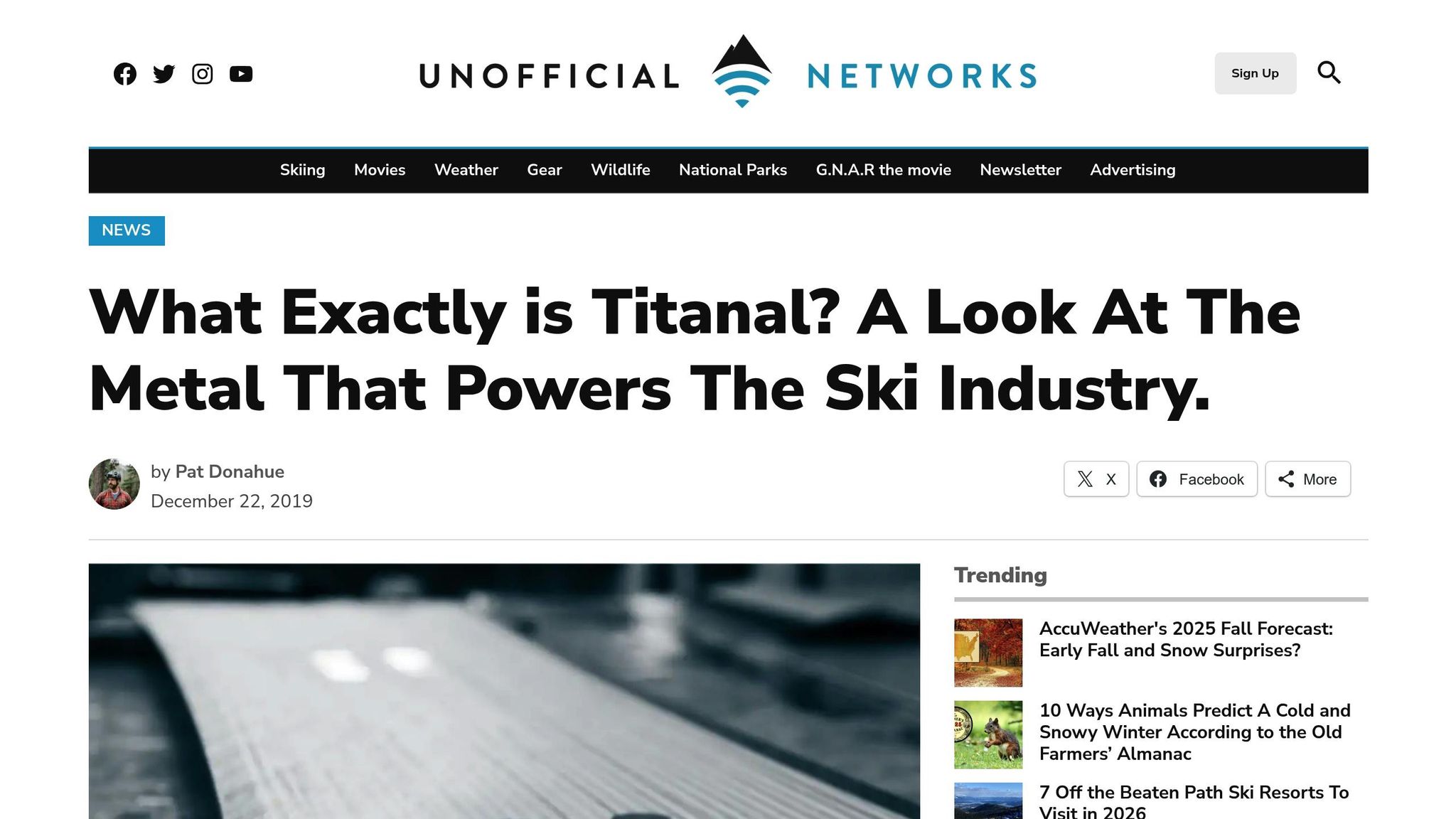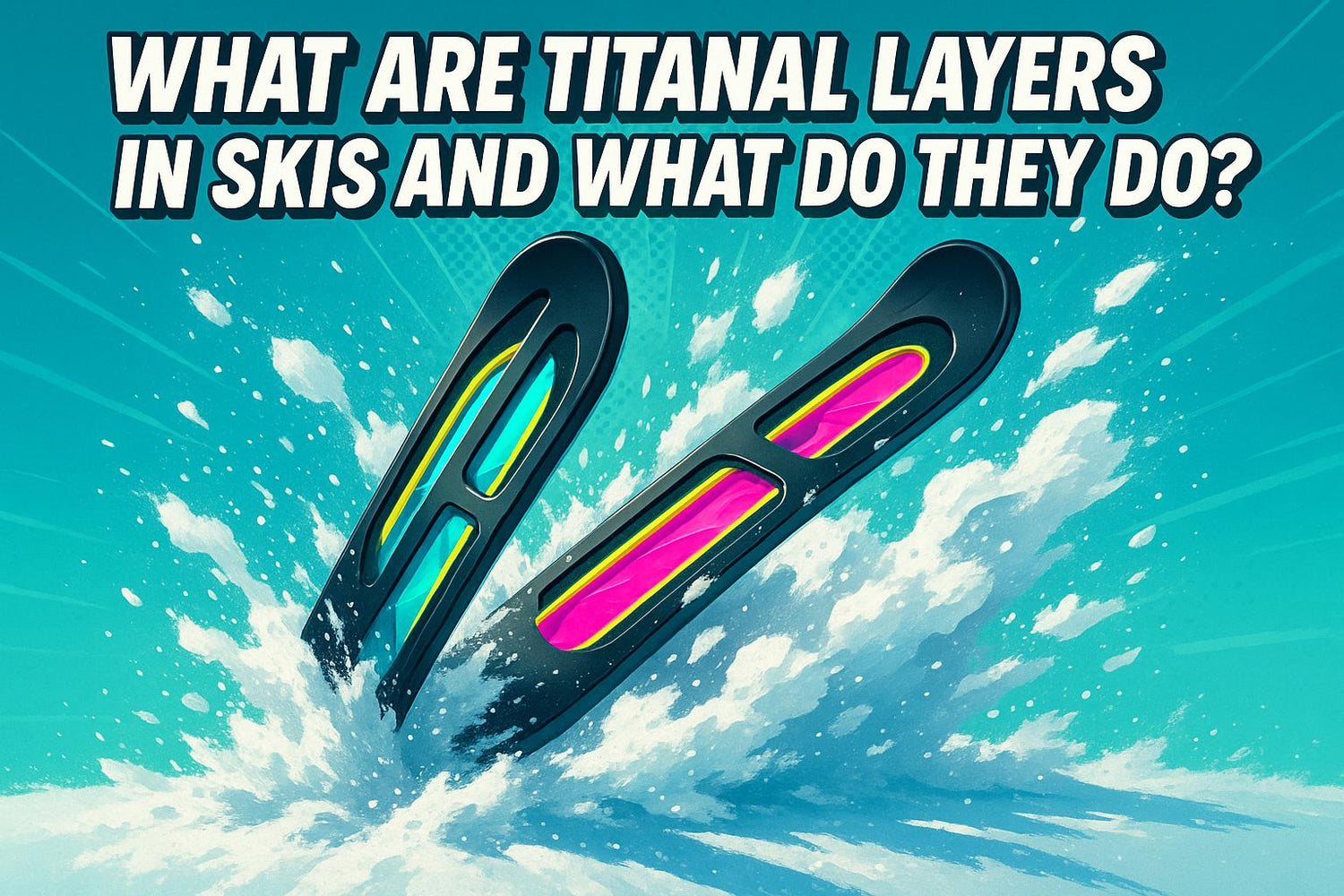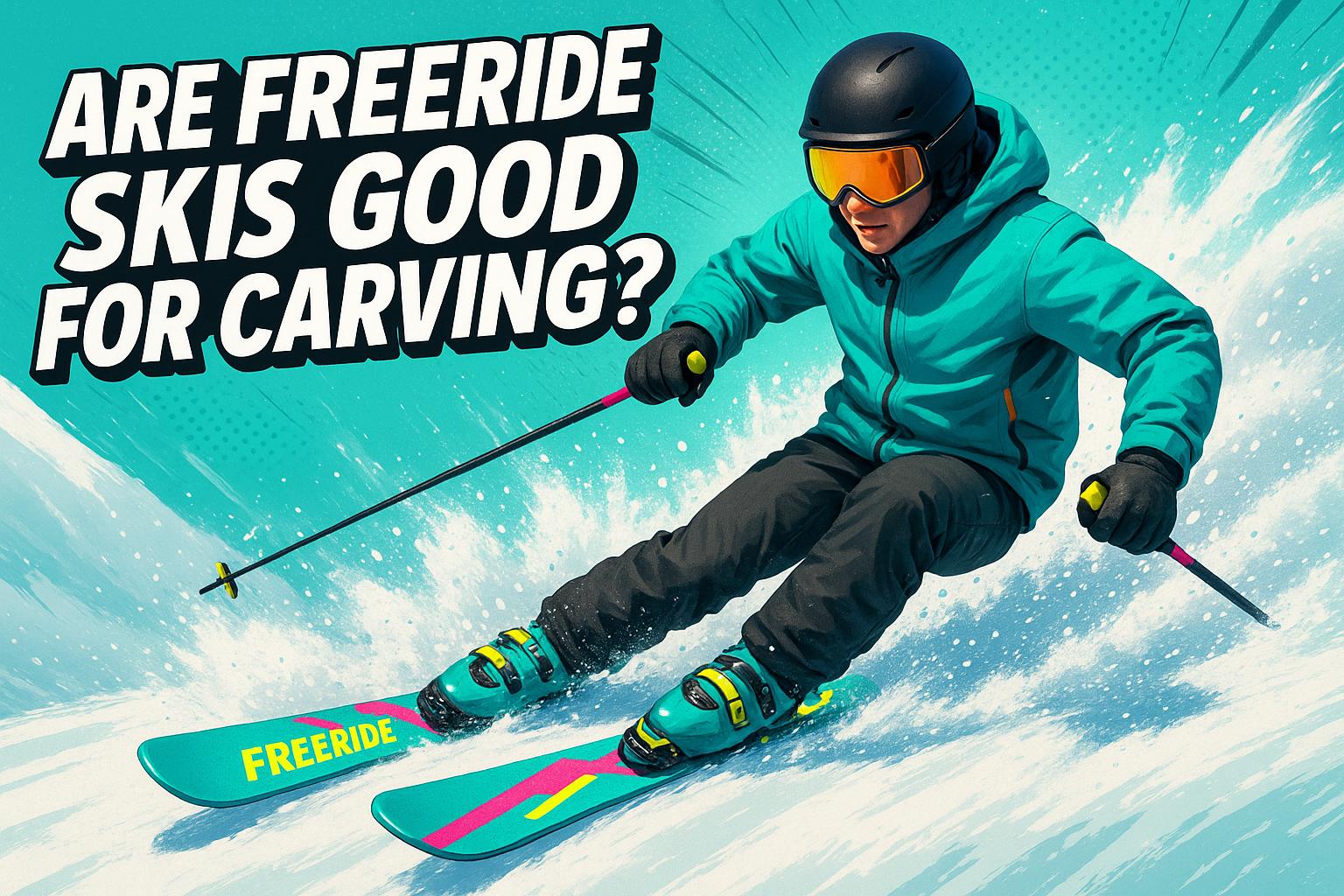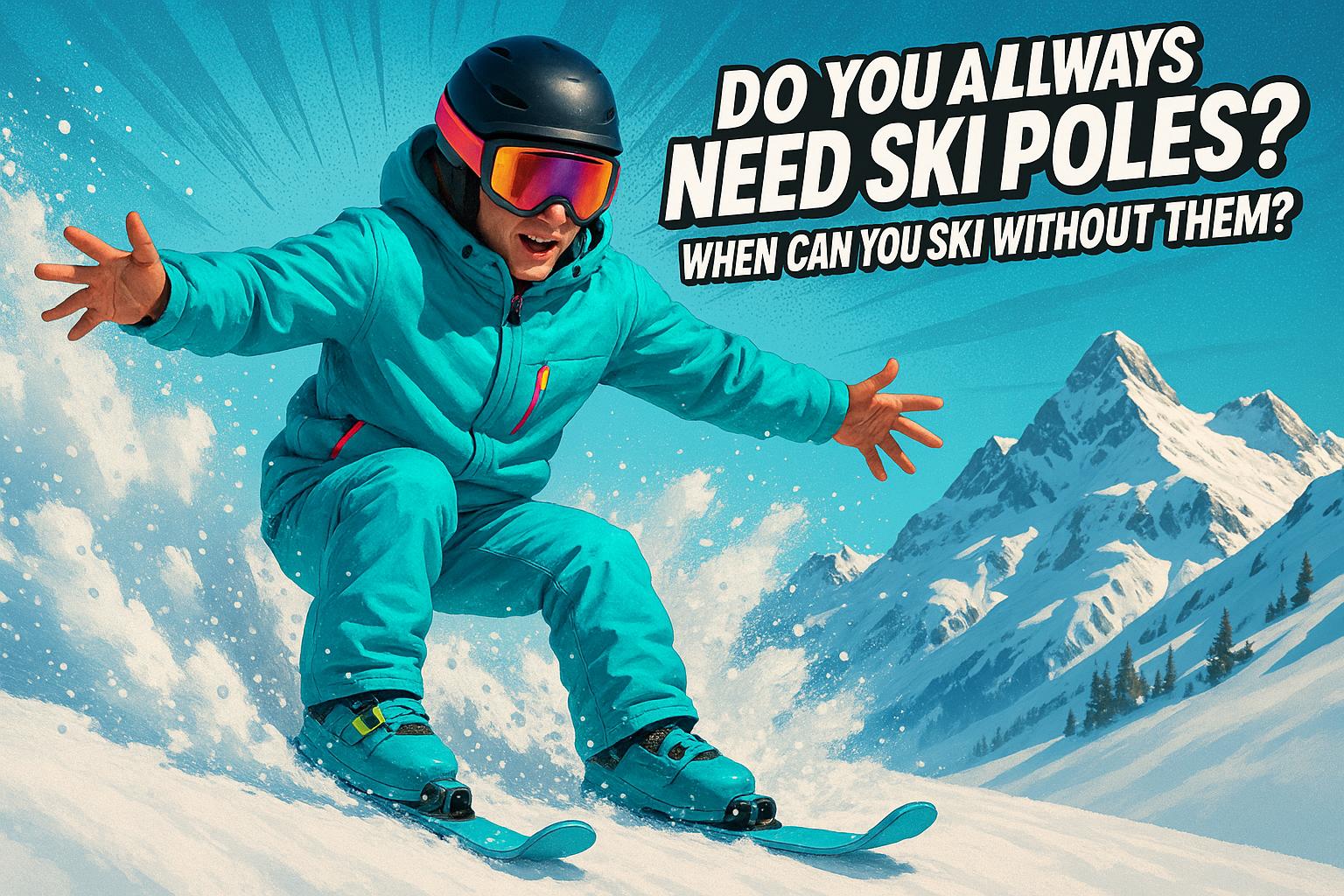Titanal-lagen zijn metalen verstevigingen in ski's die de controle, stabiliteit en trillingsdemping verbeteren, vooral bij hoge snelheden. Ze zijn favoriet bij gevorderde skiërs die precisie en prestaties waarderen. Maar ze voegen gewicht toe, waardoor ze minder wendbaar en moeilijker te hanteren zijn voor recreatieve gebruikers.
Aan de andere kant laten Snowfeet* short skis het metaal achterwege en richten ze zich op lichtgewicht, compacte ontwerpen die gemakkelijk te gebruiken, draagbaar en beginner-vriendelijk zijn. Ze zijn perfect voor leuk, flexibel skiën op verschillende terreinen.
Belangrijkste punten:
- Titanal Skis: Het beste voor snelheid en controle, maar zwaar en veeleisend. Ideaal voor experts.
- Snowfeet*: Lichtgewicht, draagbaar en vergevingsgezind. Geweldig voor beginners en recreatieve skiërs.
Snelle Vergelijking:
| Kenmerk | Titanal Ski's | Snowfeet* Short Skis |
|---|---|---|
| Stabiliteit | Focus op high-speed carving | Gebalanceerd voor alle niveaus |
| Gewicht | Zwaar | Ultra-licht |
| Controle | Precies maar stijf | Soepel en vergevingsgezind |
| Trillingen | Metaal dempt het geratel | Korte lengte vermindert het |
| Draagbaarheid | Lomp en zwaar | Rugzakvriendelijk |
| Prijs | $1,000+ | $150–$690 |
Als je houdt van agressief skiën op hoge snelheid, zijn Titanal-ski's de moeite waard. Maar voor een leuke, makkelijk te leren ervaring zijn Snowfeet* short skis een uitstekende keuze.
Hebben jouw ski's TITANAL NODIG Titanal? Wat doet het?

1. Traditionele ski's met Titanal-lagen
Grote namen zoals Rossignol, Salomon, Völkl en K2 hebben hun reputaties opgebouwd rond Titanal-versterkte ski's die gericht zijn op prestatiegericht skiën. Deze ski's bevatten metalen lagen die ontworpen zijn om de structurele sterkte te verhogen en precieze controle te bieden. Laten we eens bekijken hoe Titanal-lagen invloed hebben op enkele belangrijke prestatiefactoren.
Stabiliteit en torsiestijfheid
Titanal-lagen voegen stijfheid toe aan ski's, waardoor ze een solide kantencontact behouden en het trillen verminderen. Dit betekent meer stabiliteit tijdens agressief carven of snelle afdalingen. Maar hier is de catch: deze ski's vereisen een meer gevorderde techniek en kunnen onverbiddelijk aanvoelen voor recreatieve skiërs.
Het extra metaal verhoogt ook de torsiestijfheid (in feite weerstand tegen draaien). Dit geeft je betere kanten grip en controle, wat een grote winst is voor racers en iedereen die prestaties nastreeft. Aan de andere kant, als je meer van een speelse, ontspannen skistijl houdt, kan de extra stijfheid snelle bochten wat houterig laten aanvoelen.
Trillingsdemping
Een van de opvallende voordelen van Titanal-lagen is hun vermogen om trillingen te absorberen. Of je nu door oneffen terrein raast of hoge snelheden haalt, deze eigenschap zorgt voor een soepelere rit. Dat gezegd hebbende, kunnen sommige skiërs het gevoel hebben dat ze wat van de natuurlijke feedback van de sneeuw verliezen, wat de ervaring minder verbonden kan maken.
Draagbaarheid
Hier ligt de compromis van Titanal-ski's: ze zijn gebouwd voor prestaties, niet voor gemak. Hun stevige constructie betekent vaak dat ze zwaarder en omvangrijker zijn, wat ze lastiger maakt om te hanteren en op te bergen. Als je veel reist met je uitrusting, is dit iets om rekening mee te houden.
2. Snowfeet* Short Skis

Traditionele ski's vertrouwen vaak op metalen lagen, zoals Titanal, om de prestaties te verbeteren, maar deze aanpak brengt ook uitdagingen met zich mee. Snowfeet* heeft het anders aangepakt met een ontwerp dat de zware metalen versteviging helemaal overslaat. In plaats daarvan richten hun korte ski's en skiblades zich op slimme constructie om stabiliteit, controle en wendbaarheid te bieden. Het is een frisse kijk op skidesign, met een lichtere en veelzijdigere optie voor winterliefhebbers.
Stabiliteit
Snowfeet* bereikt stabiliteit door te kiezen voor een lager zwaartepunt, dankzij hun compacte ontwerp (variërend van 15 tot 47 inch). In tegenstelling tot traditionele Titanal-ski's die afhankelijk zijn van stijfheid, bieden deze kortere ski's betere balans en zijn ze gemakkelijker te beheersen.
Dit maakt ze vooral aantrekkelijk voor beginners en gevorderde skiërs die Titanal-versterkte ski's te veeleisend kunnen vinden. Door hun kortere lengte is de kans kleiner dat je een kant pakt, en het herstellen van kleine fouten gaat veel sneller. Het resultaat? Een soepelere, aangenamere ervaring voor skiërs van alle niveaus.
Torsiestijfheid
Zelfs zonder metalen versteviging bieden Snowfeet* ski's nauwkeurige kantencontrole. Hun houten kernconstructie en zorgvuldig ontworpen flexpatronen zorgen voor responsief draaien terwijl de rit speels en vergevingsgezind blijft. Of je nu Skiskates (17 inch) of Skiblades (26-39 inch) gebruikt, je vindt een balans tussen controle en plezier.
Deze flexibiliteit betekent dat je vol vertrouwen kunt carven zonder vast te zitten aan elke beweging, wat vaak het geval is bij stijvere, metaalgelaagde skis. Het is een ontwerp dat zich goed aanpast aan verschillende omstandigheden, waardoor skiën zowel plezierig als toegankelijk wordt.
Trillingsdemping
De kortere lengte van Snowfeet* skis vermindert van nature trillingen, gebaseerd op natuurkunde in plaats van extra materialen. Met minder ski-oppervlak dat ruis van oneffen sneeuw oppikt, geniet je van een soepelere rit. De houten kern en geoptimaliseerd ontwerp versterken dit effect, waardoor alles stabiel blijft zonder je verbinding met de sneeuw te dempen.
Deze balans tussen soepelheid en feedback helpt skiërs van alle niveaus hun techniek te verfijnen. Je voelt je meer verbonden met het terrein terwijl je toch geniet van een comfortabele rit.
Draagbaarheid
Als het op draagbaarheid aankomt, overtreffen Snowfeet* de traditionele Titanal skis. Hun lichtgewicht, compacte ontwerp is een game-changer. Bijvoorbeeld, de Mini Ski Skates passen in een rugzak, en zelfs de langste Snowfeet* Short Skis (47 inch) zijn nog steeds veel korter dan standaard skis.
Doordat ze aanzienlijk lichter zijn dan metaalversterkte opties, zijn deze skis perfect voor reizen, wandelen naar afgelegen plekken, of zelfs een snelle sessie in je achtertuin. Geen omvangrijke opslag of zwaar tillen nodig. Pak ze gewoon en ga, wat nieuwe mogelijkheden opent voor waar en hoe je kunt genieten van skiën. Het is gemak opnieuw gedefinieerd voor wintersportliefhebbers.
sbb-itb-17ade95
Voor- en nadelen vergelijking
Laten we het opsplitsen: traditionele Titanal skis en Snowfeet* short skis brengen elk hun eigen sterke en zwakke punten mee. Hier is een snelle vergelijking naast elkaar van hoe ze zich verhouden.
Traditionele Titanal skis blinken uit bij high-speed, agressief carven dankzij hun stevige, metaalversterkte constructie. Diezelfde bouw maakt ze echter zwaarder en lastiger te hanteren. Aan de andere kant richten Snowfeet* short skis zich op eenvoud en draagbaarheid, met een lichtgewicht ontwerp dat makkelijk te gebruiken en te beheersen is.
Snowfeet* kiest een andere benadering van ski-ontwerp. Door de zware metalen lagen over te slaan en te vertrouwen op slimme engineering, leveren deze short skis solide prestaties terwijl ze compact en beginner-vriendelijk zijn. Hun kleine formaat maakt ze gemakkelijk op te bergen en perfect voor reizen.
Hier is een snelle vergelijking van de twee:
| Kenmerk | Traditionele Titanal Skis | Snowfeet* Short Skis |
|---|---|---|
| Stabiliteit | Gebouwd voor high-speed carving | Gebalanceerd voor alle vaardigheidsniveaus |
| Gewicht | Zwaar door metalen lagen | Ultralicht en gemakkelijk te hanteren |
| Torsiestijfheid | Stijf voor precieze kantencontrole | Flexibel voor soepelere, vergevingsgezinde controle |
| Trillingsdemping | Metaal vermindert getril | Korte lengte minimaliseert van nature trillingen |
| Draagbaarheid | Heeft gespecialiseerd transportmateriaal nodig | Klein genoeg om in een rugzak te passen |
| Leercurve | Steiler, vereist gevorderde techniek | Makkelijk te leren en vooruitgang te boeken |
| Prijsklasse | Premium prijsstelling | Betaalbaarder, van $150 tot ongeveer $690 |
| Terrein veelzijdigheid | Het beste op geprepareerde skigebieden | Werkt op pistes, parken, achtertuinen en paden |
Het prijsverschil weerspiegelt hun ontwerpfilosofieën. Traditionele ski's hebben vaak een stevig prijskaartje vanwege hun hoogwaardige materialen en vakmanschap. Snowfeet* daarentegen biedt een budgetvriendelijke optie die niet inlevert op plezier of functionaliteit, waardoor ze een geweldige keuze zijn voor zowel recreatieve gebruikers als ervaren skiërs.
Nog iets om rekening mee te houden: onderhoud. Traditionele ski's hebben regelmatig professioneel onderhoud nodig om in topconditie te blijven. Snowfeet* ski's? Die zijn onderhoudsarm, zodat je minder tijd kwijt bent aan gedoe en meer tijd op de sneeuw kunt doorbrengen.
Wat Snowfeet* echt onderscheidt, is hun veelzijdigheid. Terwijl traditionele ski's vooral zijn afgestemd op gebruik in skigebieden, opent Snowfeet* een wereld aan mogelijkheden. Of je nu de pistes afcarvet, tricks oefent in het park, door je achtertuin cruiset of wandelpaden verkent, deze short skis zijn er klaar voor.
Welke optie past bij jou
De keuze tussen traditionele ski's met Titanal-lagen en Snowfeet* short skis komt echt neer op wat voor ervaring je zoekt op de piste. Voor de meeste recreatieve skiërs - vooral degenen die net beginnen of op een gemiddeld niveau zitten - zijn Snowfeet* short skis vaak de betere keuze. Laten we de belangrijkste verschillen in prestaties en gemak eens bekijken.
Traditionele Titanal ski's zijn gebouwd voor gevorderde skiërs die graag agressief carven bij hoge snelheden op geprepareerde pistes. Deze ski's zijn ontworpen voor precisie en kracht, met maximale kanten grip voor race-achtige bochten. Maar hier is de catch - ze zijn niet vergevingsgezind. De metaalversterkte constructie vraagt veel energie, techniek en kracht om goed te hanteren. Als je solide basisvaardigheden hebt en graag je grenzen verlegt, zijn deze ski's iets voor jou.
Aan de andere kant draait het bij Snowfeet* short skis allemaal om eenvoud en plezier. Ze zijn perfect voor skiërs die een gebruiksvriendelijke optie met een snelle leercurve willen. Of je nu over een skipiste cruiset, tricks oefent in het terrain park, of gewoon speelt in je achtertuin, deze short skis zijn gebouwd om alles aan te kunnen. Ze geven prioriteit aan wendbaarheid en controle, waardoor ze ideaal zijn voor recreatieve skiërs die willen genieten zonder te worstelen met veeleisende uitrusting.
Nog een groot pluspunt? De prijs. Traditionele Titanal ski's kunnen je gemakkelijk meer dan $1.000 kosten. Snowfeet* biedt echter een veel betaalbaarder alternatief. Hun 44 CM skiskates beginnen bij $390, terwijl hun langere 140 CM modellen oplopen tot $699,90. Dat is veel prestatie zonder het hoge prijskaartje.
Voor de meeste recreatieve skiërs is de lichtere, flexibelere bouw van Snowfeet* short skis een echte game-changer. Ze maken skiën minder inspannend en meer gericht op genieten van je tijd op de berg. Bovendien zijn ze een geweldige manier om frustratie te vermijden die kan ontstaan bij zwaarder, stijver materiaal zoals Titanal ski's.
Veelgestelde vragen
Wat zijn Titanal-lagen in ski's en hoe verbeteren ze de prestaties voor gevorderde skiërs?
Titanal-lagen zijn metalen verstevigingen ingebouwd in ski's om de stabiliteit, torsiestijfheid en trillingsdemping te verbeteren. Deze eigenschappen maken ski's responsiever en gemakkelijker te hanteren, vooral bij hoge snelheden of scherpe, agressieve bochten. Gevorderde skiërs houden van Titanal vanwege het vermogen om trillingen te absorberen, wat het getril vermindert en een soepelere rit levert, zelfs op moeilijk terrein.
Dat gezegd hebbende, Titanal kent ook nadelen. Het extra gewicht en de stijfheid zijn misschien niet ideaal voor iedereen. Als je iets lichters en wendbaarders zoekt, zijn Snowfeet producten een uitstekende keuze. Snowfeet's korte ski's en skiblades slaan de zware metalen lagen over maar bieden toch indrukwekkende prestaties. Ze zijn perfect voor iedereen die wendbaarheid, bewegingsvrijheid en een leuke, veelzijdige ervaring waardeert - allemaal zonder in te leveren op controle of stabiliteit.
Wat maakt Snowfeet korte ski's beter voor beginners vergeleken met traditionele ski's met Titanal-lagen?
Snowfeet korte ski's zijn een fantastische optie voor beginners omdat ze lichtgewicht, compact en super gemakkelijk te gebruiken zijn. In tegenstelling tot traditionele ski's met zware Titanal-lagen, die stijf en overweldigend kunnen aanvoelen, zijn Snowfeet vergevingsgezinder. Hun kleinere formaat helpt de kans op vallen te verkleinen, waardoor je het vertrouwen krijgt om sneller te leren en te verbeteren. Bovendien zijn ze makkelijk mee te nemen en op te bergen, wat je winteruitjes zorgeloos maakt.
Traditionele Titanal ski's draaien om geavanceerde eigenschappen zoals stabiliteit en torsiestijfheid, wat intimiderend kan zijn voor nieuwkomers. Snowfeet daarentegen zijn ontworpen met eenvoud en plezier in gedachten. Ze zijn perfect voor iedereen die net begint en een plezierige en ontspannen introductie tot skiën wil - zonder te worstelen met logge, high-performance uitrusting.
Hoe beïnvloedt het gewicht van Titanal ski's hun prestaties en gebruiksgemak op verschillende terreinen?
Als het gaat om Titanal ski's speelt hun gewicht een grote rol in hoe ze presteren en omgaan. De Titanal-lagen geven deze ski's stabiliteit en torsiestijfheid, wat ze laat uitblinken op hoge snelheid en ijzige of hard gepakte hellingen. Maar er is een afweging: het extra gewicht kan ze minder wendbaar maken, dus snelle bochten of het zigzaggen door smalle plekken zoals buckels of boslopen kan moeilijker aanvoelen.
Aan de andere kant zijn Snowfeet producten gemaakt van lichte materialen die zich richten op wendbaarheid en veelzijdigheid. Dit ontwerp maakt ze perfect voor scherpe, snelle bochten en het aanpakken van verschillende terreinen. Ze zorgen voor een levendige, leuke ervaring, vooral vergeleken met het zwaardere gevoel van Titanal ski's. Als je iets lichts, behendigs en vol plezier zoekt, is Snowfeet een geweldige match voor de skiërs van vandaag.


































Laat een reactie achter
Deze site wordt beschermd door hCaptcha en het privacybeleid en de servicevoorwaarden van hCaptcha zijn van toepassing.